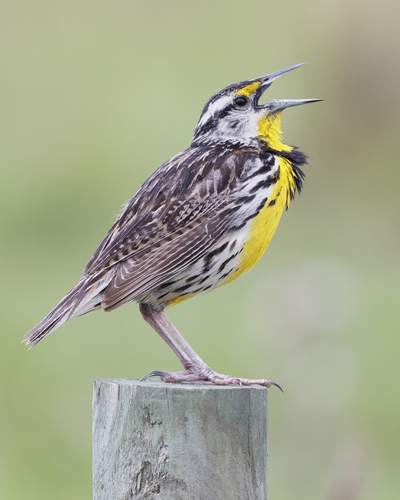
Eastern Meadowlark
The Eastern Meadowlark (Sturnella magna) is a striking songbird found across North and South America. It is known for its bright yellow breast marked with a distinctive black 'V' and its flute-like, melodious song. It plays a significant role in its ecosystem by controlling insect populations and dispersing seeds. While not globally threatened, the species faces significant population declines in many areas due to habitat loss.
19-28 cm
Length
35-40 cm
Wingspan
Near Threatened
Conservation Status
Distribution
The Eastern Meadowlark's range extends from eastern North America, through Central America, and into northern South America. In North America, it breeds from southeastern Canada south to the Gulf Coast and west to the Great Plains. Migratory populations winter in the southern part of the breeding range and south into Mexico.
Lifespan
Typically 3-5 years in the wild, though some individuals may live longer.
Eastern Meadowlark's Habitat
Habitat Types
Grasslands, Pastures, Savannas, Agricultural fields (hayfields)
Climate Zones
Temperate, Subtropical, Tropical
Adaptations
Their ground-nesting habits and coloration provide camouflage within grassland environments. Strong legs and feet are well-suited for walking and running through dense vegetation.
Variations
There are numerous recognized subspecies (around 17) of the Eastern Meadowlark, differing subtly in plumage and size. These variations are often tied to specific geographic regions.
Appearance
Breeding Plumage
Breeding plumage is brighter, with more vibrant yellow and a more sharply defined black 'V'. Non-breeding plumage is duller and more streaked.
Seasonal Feather Changes
Plumage becomes worn and faded throughout the breeding season, with a molt into fresher plumage in late summer.
Sex Based Plumage Differences
While both sexes have the characteristic yellow breast and black 'V', males tend to have brighter coloration and a more defined pattern.
Notable Features
Bright yellow breast with a black 'V', Streaked brown and buff back, White outer tail feathers visible in flight, Long, pointed bill
Diet and Feeding
Primary Foods
Insects, Spiders, Seeds, Grains
Foraging Behavior
Eastern Meadowlarks primarily forage on the ground, probing the soil with their bills and gleaning insects and seeds from low vegetation. They often walk or run rather than hop.
Specializations
Their strong, pointed bill is well-suited for probing the ground and manipulating small food items.
Seasonal Diet Variations
Their diet shifts seasonally. During the breeding season, they consume mostly insects, providing protein for growing chicks. In winter, they rely more heavily on seeds and grains.
Behavior
Social Structure
Eastern Meadowlarks are generally territorial during the breeding season, with males defending territories against other males. Outside of breeding, they may form small flocks.
Communication
A clear, flute-like song, often described as a series of descending whistles., Various call notes, including a sharp 'dzert' and a rattling chatter., Visual displays, such as spreading the tail to show white outer feathers.
Migration
Northern populations are migratory, moving south for the winter. Southern populations may be resident year-round.
Territorial or Group Behaviors
Males establish and defend territories through song and visual displays. They may engage in physical altercations with rivals.
Conservation
Threats
Habitat loss due to agriculture and urbanization, Pesticide use, Nest predation by various animals, Collisions with vehicles and structures
Protection Programs
Conservation Reserve Program (CRP) in the US, Habitat restoration initiatives, Efforts to reduce pesticide use in agricultural areas
Local National Laws
Protected under the Migratory Bird Treaty Act in the US and Canada.
Population Trend
Decreasing
Population Estimates
The global population is estimated to be around 44,000,000, but with significant declines in many areas.
Interesting Facts
Eastern and Western Meadowlarks look very similar
But their songs are distinctly different, and they rarely hybridize where their ranges overlap.
They are known for their 'flight songs'
Males will sometimes sing while flying, especially during courtship displays.
The oldest recorded Eastern Meadowlark
Was at least 7 years and 2 months old.
Faqs about Eastern Meadowlark
What is the difference between an Eastern and Western Meadowlark?
While visually very similar, their songs are distinct. The Eastern Meadowlark has a clear, flute-like song, while the Western Meadowlark's song is more complex and gurgling.
What can I do to help Eastern Meadowlarks?
Support grassland conservation efforts, avoid pesticide use on your property, and keep cats indoors to reduce predation.
Are Eastern Meadowlarks endangered?
They are classified as Near Threatened by the IUCN, meaning they are not currently endangered but face significant threats and population declines.
Copyright @ Nature Style Limited. All Rights Reserved.
 English
English